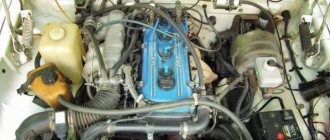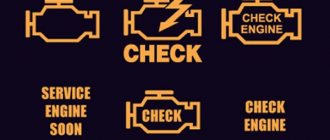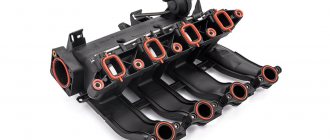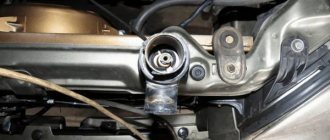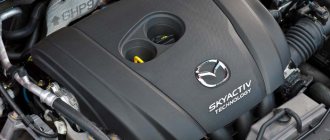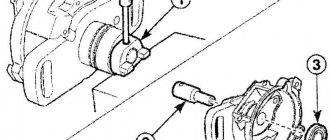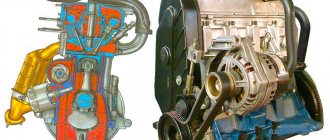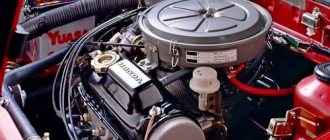The speed of the ZMZ 406 injector floats
The engine does not maintain constant speed, the speed pulsates from 900 to 1400, sometimes jumps to 3000. The engine management system warning lamp lights up on the dashboard.
I replaced the idle air valve, ignition coils, and temperature sensor on the thermostat, but the problem did not go away. Previously, it disappeared when the coolant was heated to 90°C, but now the engine control system indicator light is constantly on and the speed pulsates, both when parked and while driving.
What could be the reason?
- High idle speed on a GAZ 3110 with a Solex carburetor - 3 answers
- Reduced speed floats when driving - 1 answer
- When coasting, when you turn off the speed, the car stalls - 1 answer
You need to carry out diagnostics with a scanner, read the errors and carry out a series of checks on them. If the check light is on, it means there are errors in the ECU memory; diagnostics will show exactly what the problem is.
Also check the operating parameters of the throttle position sensor, check for air leaks in the intake, then you should check the pressure in the fuel system and the spray of the injectors, BUT first you need to read the error code.
Apparently we are talking about the ZMZ406 motor?
I had operating experience with it. Not the most successful engine. Two chains, tensioners, dampers and a bunch of gears were installed on the 4-cylinder block. Two ignition coils, not the most reliable, for some reason often fail.
The engine control system warning lamp, the so-called “check”, most likely lit up the oxygen sensor due to an unbalanced mixture. And this unbalanced mixture can be created by unaccounted for air leaks into the intake manifold. Where it is leaking, you can look for it with a can of spray. With the engine running, spray all joints and connections. As soon as the jet hits the leak point, the engine speed will immediately change.
And just in case, a question: is the engine air filter clean? In fact, for testing, you can start the engine without this filter. And check the fuel pressure. Otherwise, it may be difficult for gasoline to flow to the injectors.
The engine is the “heart” of a car, and like the human heart, interruptions sometimes occur in the functioning of this “organ”. We become aware of problems with the engine by reading the rpm. If the speed of the power unit begins to float, the engine gives us a signal that something is wrong with it. In our material today we will tell you what breakdowns are hinted at by jumping engine speeds, how to correctly diagnose and repair them.
The reason for the appearance of floating speed
The driver can find out that there is something wrong with the engine speed by looking at the tachometer. During normal operation of the power unit at idle, the needle of this device remains at the same level (usually within 750-800 rpm), and if the engine has problems, the needle either falls or rises (range from 500 to 1,500 rpm and higher). If the car does not have a tachometer, then the floating speed can be heard by ear: the rumble of the engine either increases or decreases. And also - by the increasing and decreasing vibrations penetrating into the car interior from the engine compartment.
As a rule, unstable engine speed occurs at idle. But even at intermediate engine speeds, dips or rises in the tachometer needle can be detected - this is typical for diesel engines. Let's consider these two cases separately to understand why these phenomena occur.
Speed jumps at idle
Floating idle speed most often occurs on injection engines. This is due to the peculiarity of regulating the operation of the idle system by the electronic engine control unit (ECU). The electronic “brains” of the car constantly read information about the idle speed, and if it is violated, they give a command to the sensors responsible for the correct functioning of the system to correct the situation.
Idling may be disrupted due to excess air getting into the fuel system, and specifically into the engine cylinders. In this case, the mass air flow sensor signals the ECU that excess air has entered the combustion chamber. To equalize the amount of air and fuel that together form the air-fuel mixture, the “brains” command the injector valves to open and let more fuel into the cylinders. At this moment, the engine speed increases sharply.
Then the ECU “realizes” that it has supplied too much fuel to the cylinder and limits its supply - at this moment the speed drops sharply.
The second reason for floating speed at idle is the failure of the idle speed controller (IAC).
It is an electric motor, the design of which includes a conical needle, and its function is to stabilize the engine speed when it is idling. The main reason for its breakdown is wear of the IAC elements (wire breakage, wear of guides or cone needle drive, etc.) due to long-term operation of the vehicle on low-quality fuel. When the regulator breaks down, the engine, left without a “stabilizer,” begins to involuntarily increase or decrease speed.
The third reason for speed fluctuations is a malfunction of the oil sump ventilation valve.
During engine operation, exhaust gases accumulate in the crankcase (they are also called crankcase gases). If the engine is new, then the volume of such gases in the crankcase is relatively small, while an engine with high mileage has an increased amount of crankcase gases.
Excess of these gases is removed through the ventilation system to the intake manifold and throttle valve, where they participate in the formation of the air-fuel mixture in the engine combustion chambers.
If the crankcase ventilation valve jams (usually this happens due to the deposition of oil residues contained in the crankcase gases on its walls), a smaller amount of crankcase gases enters the intake manifold, the fuel injection valve is not fully enriched, and the engine speed begins to fluctuate - from average ( 1100 - 1200) to low (750-800).
Error codes
When the electrical circuit of the car has become clear, you can consider the errors of the electronic engine control unit, which will help to accurately recognize the malfunction, as well as eliminate them in a timely manner.
Designation of fault codes
- 1 P0016 Temporary inconsistency (phase shift) of the camshaft and crankshaft
- 2 P0031 Short circuit of the oxygen sensor heater circuit
- 3 P0032 Open circuit of the oxygen sensor heater
- 4 P0068 Throttle position sensor error (mismatch with absolute pressure sensor)
- 5 P2074 Absolute pressure sensor error (mismatch with throttle position sensor)
- 6 P0071 Ambient temperature sensor error (mismatch with other sensors)
- 7 P0072 Short circuit of the ambient temperature sensor circuit
- 8 P0073 Open circuit of the ambient temperature sensor
- 9 P0107 Short circuit of the pressure sensor circuit
- 10 P0108 Pressure sensor circuit open
- 11 P0111 Intake air temperature sensor error
- 12 P0112 Short circuit of the intake air temperature sensor circuit
- 13 P0113 Open air temperature sensor circuit
- 14 P0116 The performance characteristics of the coolant temperature sensor are not normal
- 15 P0117 Short circuit of the coolant temperature sensor circuit
- 16 P0118 Open circuit of the coolant temperature sensor
- 17 P0122 Short circuit of the throttle position sensor circuit
- 18 P0123 Open circuit of the throttle position sensor
- 19 P0125 Insufficient cooling temperature for fuel control feedback
- 20 P0128 Thermostat malfunction
- 21 P0129 Incorrect reading of the absolute pressure sensor when the ignition is turned off
- 22 P0131 Short circuit of the oxygen sensor circuit
- 23 P0132 Open circuit of the oxygen sensor
- 24 P0133 Slow response of the oxygen sensor to changes in the composition of the mixture
- 25 P0135 Oxygen sensor heater performance is not normal
- 26 U0155 No messages on the data bus
- 27 P0171 Poor fuel mixture (no feedback from the oxygen sensor)
- 28 P0172 Rich fuel mixture (no feedback from oxygen sensor)
- 29 P0201 Open circuit of injector No. 1
- 30 P0202 Open circuit of injector No. 2
- 31 P0203 Open circuit of injector No. 3
- 32 P0204 Open circuit of injector No. 4
- 33 P0300 Missing working process on all cylinders
- 34 P0301 Missing stroke of cylinder No. 1
- 35 P0302 Missing stroke of cylinder No. 2
- 36 P0303 Missing stroke of cylinder No. 3
- 37 P0304 Missing stroke of cylinder No. 4
- 38 P0315 Incorrect signal from the crankshaft sensor
- 39 P0325 Knock sensor circuit
- 40 P0335 Open circuit of the crankshaft position sensor
- 41 P0339 Missing signal pulses from the crankshaft position sensor
- 42 P0340 Open circuit of the camshaft position sensor
- 43 P0344 Missing signal pulses from the camshaft and crankshaft position sensor
- 44 P0443 Open circuit of the canister purge valve
- 45 P0480 Fan control relay circuit open
- 46 P0501 Performance characteristics of the vehicle speed sensor signal are normal
- 47 P0506 Idle speed higher than specified
- 48 P0507 Idle speed below specified
- 49 P0508 Open circuit of the idle speed regulator
- 50 P0509 Short circuit of the idle regulator circuit
- 51 P0516 Open circuit of the battery temperature sensor
- 52 P0517 Low signal level of battery temperature sensor
- 53 P0532 Low signal level of the air conditioner pressure sensor
- 54 P0533 Open air conditioner pressure sensor circuit
- 55 P0562 Low battery voltage
- 56 P0563 Battery voltage high
- 57 P0600 Malfunctions of the internal circuits of the control unit
- 58 P0601 Internal memory checksum error
- 59 P0622 Malfunction of the generator excitation winding circuit
- 60 P0627 Open circuit of the fuel pump relay
- 61 P0630 VIN is not programmed into the control unit
- 62 P0632 Odometer is not programmed in the control unit
- 63 P0645 Open circuit of the compressor clutch relay
- 64 P0685 Main relay circuit open
- 65 P0688 Open circuit of main relay contacts
- 66 P1115 Temperature sensor mismatch
- 67 P1603 Internal error CU transmission of dual-port RAM
- 68 P1604 Internal error CU writing / reading dual-port RAM
- 69 P1607 Counts incorrectly in “-”
- 70 P2610 Counts incorrectly in “+”
- 71 P1696 Error in the control unit prohibiting writing to the EEPROM
- 72 P1697 Error control unit incomplete programming
- 73 P2096 Low fuel mixture signal
- 74 P2097 Rich fuel mixture signal
- 75 P2302 Insufficient ionization of the secondary circuit of ignition coil No. 1
- 76 P2305 Insufficient ionization of the secondary circuit of ignition coil No. 2
- 77 P2503 Low output level of the charging system
How to adjust the throttle valve and set the position angle?
An analogue of a modern car is a device made up of many components and assemblies. Deviations in the operation of the smallest component can lead to quite serious problems. The throttle position sensor (TPS) is one example of this type of component. And adjusting the throttle valve is an integral element of routine diagnostics of any car.
The throttle valve is presented in the form of an air valve, the functional task of which is to regulate the amount of air entering the engine. The fundamental features of the unit include a change in the cross-section of the air channel. When it is open, air flows smoothly through the intake manifold.
The throttle position sensor, located here, determines the opening angle. This function is carried out through its communication with the engine control unit. The signals coming from the sensor contribute to the issuance of a command from the control unit to increase the amount of injected combustible mixture.
Thus, the working mixture is enriched, and the engine operates closer to maximum speed.
Its sensor includes two types of resistors:
- Single-turn constant.
- Variable.
The sum of their resistance is approximately 8 kOhm. The reference voltage here is supplied to one of the outer terminals from the controller, and the second terminal is connected to ground. Thanks to this, a signal is sent to the controller, informing about the current position of the throttle valve. The value of the pulse voltage depends on the position level of the element, the standard interval of which is 0.7 to 4 W.
Important: the open state of the unit indicates the pressure level in the intake system of the vehicle is similar to atmospheric pressure; when closed, this value decreases to the vacuum state.
Type diversity
Everyone knows two types of TPS:
- Sample with a mechanical drive type.
- Unit with electric drive type.
Throttle position sensor
The first type is being introduced in economy class vehicles. The complete set of elements is combined in a separate block, which includes the following parts:
- frame;
- throttle valve;
- sensor;
- idle speed controller.
As an addition, there are also pipes located here, the functional task of which is to ensure the operation of gasoline vapor recovery and crankcase ventilation systems.
The damper housing is part of the cooling system. The functional task of the idle speed controller is to maintain the crankshaft speed in the closed position of the damper when starting or warming up the engine. The IAC is a stepper motor and valve. The functional tasks of these parts are to regulate the air supply entering the intake system bypass.
In modern conditions, most manufacturing plants equip machines with electric-type dampers. These elements are characterized by their own electronic control system. Thus, the optimal amount of torque is ensured at all speed ranges and loads of the machine. In addition to increased power and dynamics, owners receive a reduction in fuel consumption and exhaust emissions.
This element includes the following mechanisms:
- Frame.
- Throttle valve.
- Electric motor.
- Gearbox.
- Throttle position sensor.
- Return spring mechanism.
TPDZ
Differences between the electric damper type
Main functional differences:
- Lack of mechanical connection between the gas pedal and the throttle;
- Adjustment of XX by direct movement of the damper.
- The electronic system is able to independently influence the amount of torque of the internal combustion engine. This is possible due to the absence of a rigid connection between the gas pedal and the throttle valve. This condition persists even when the driver presses the accelerator.
Such functional changes are possible thanks to the operation of input-type sensors of the control unit and the actuator. This electronic control system device is additionally characterized by an accelerator pedal position sensor and a brake and clutch position switch. Thanks to all this, the engine control unit successfully responds to sensor signals, converting them to the damper module into control actions.
Alternative replacement
Sometimes there are cars with parallel installation of 2 TPS. In a functional sense, such installation will not add any power, but if one unit fails, the second one will operate uninterruptedly. Therefore, the introduction of two TPS is carried out in order to increase the reliability of the module. These elements can be either non-contact type or sliding contact type. As an addition, this module design includes an emergency damper position, which operates thanks to a return spring mechanism.
Nature of faults
Malfunctions or incorrect adjustment of the damper can be manifested in the following features:
- uncertain or difficult engine starting;
- increased fuel consumption;
- increased idle speed;
- failures when accelerating;
- Jerking when switching.
Adjustment work
It is the damper that accounts for the bulk of the work. Due to the fact that the damper is constantly involved in the moving operation of the motor, its position angle requires periodic adjustment. Please note that this process is quite painstaking. You cannot avoid replacing the throttle valve if its adjustment leads to any deviations. In order to avoid such incidents during replacement, we will consider in detail the details of correct throttle valve adjustment.
First, turn off the ignition to bring the throttle valve to the closed position. Secondly, disconnect the connector in the sensor, simultaneously checking for continuity between the terminals. Make sure there is no voltage. Then you can begin to configure and adjust the sensor. After this, you need to resort to using a 0.4 mm thick probe. It is used by placing it between the lever and the screw in parallel with the location of the throttle body gasket.
How to adjust the carburetor on a gazelle with 406 | Auto Bryansk
Everyone knows that the power of a car engine largely depends on how well its carburetor works (and the Gazelle is no exception). Sometimes during operation of the car, malfunctions in the carburetor appear, and this often happens at the most inopportune time. As you probably already guessed, today we will look at how to adjust the carburetor on a Gazelle. It must be emphasized that the Gazelle car is in most cases equipped with ZMZ-4063.10 and ZMZ-4061.10 engines, which use a K-151d carburetor.
Adjusting the carburetor K-151d (Gazelle with engine 406)
1. Remove the air filter, as well as the carburetor cover. To do this, you need to disconnect the air damper drive cable.
2. Check the level in the float chamber. It is necessary that it be at a height of 3 cm from the upper edge of the middle part of the K-151d carburetor. To take this measurement, it is recommended to use the front part of a matchbox, having first folded it in half.
3. Remove the float rod plug and make sure that the O-ring valve located on the needle valve is sealed. If there are no problems, install the upper part of the carburetor, the choke drive cable, and the air filter.
4. We begin the process of adjusting the Gazelle carburetor itself. To do this, you need to completely screw in the idle speed adjustment screw and unscrew it 5 turns.
5. We carry out similar actions with the quality screw, but unscrew it back only 3 turns.
6. Start the power unit and wait until it warms up to 90 degrees.
7. By rotating the operational adjustment screw, we select a stable engine crankshaft speed at 700-800 rpm.
8. Press the accelerator pedal and quickly release it, which must be done in order to ensure that the K-151d carburetor is adjusted correctly. If the engine stalls, it is necessary to increase the crankshaft speed, but do not exceed the permitted value.
9. We drive towards the nearest service station and adjust the CH and CO indicators of our Gazelle’s engine.
Now you know how to adjust the carburetor on a Gazelle.
The fuel system is one of the most important in a car, it ensures uninterrupted operation of the vehicle, moderate fuel consumption, and the engine life depends on its settings. The carburetor on a Gazelle with a 406 engine also plays a fairly important role, so it must be kept clean and in good technical condition.
GAZelle commercial vehicles with a ZMZ-406 engine and a similar power system have already been discontinued, but there are still quite a lot of such vehicles on Russian roads, they transport cargo and passengers. Carburetor cars have their advantages - the relative simplicity of the device, a minimum of sensors, the ability to repair the engine yourself, fairly high reliability, and the low price of spare parts.
Fuel system and ignition diagrams for Gazelle with engine 406
GAZ commercial vehicles began to be produced in 1994, at first they were equipped only with ZMZ-402 engines. Later, carburetor 16-valve engines ZMZ-4061.10 (for A-76 gasoline) and ZMZ-4063.10 (for running on Ai-92 fuel) began to be installed on these machines.
ZMZ-4063 is an internal combustion engine (ICE), which is no longer produced by the Zavolzhsky Motor Plant, but is still in use today. The engine has an electronic ignition system, but at the same time a fuel system with carburetor injection (CI), the carburetor model installed from the factory is K151D. The ignition circuit is microprocessor-based and includes the following elements:
- electronic control unit;
- two double coils;
- high-voltage wires with lugs;
- crankshaft and camshaft position sensors;
- spark plug;
- coolant temperature sensor;
- wiring (“braid”).
The power supply system (circuit) for cars with HF is very simple, consists of a minimum of components, and these are:
- gas tank;
- fuel lines, including supply and return hoses;
- fine/coarse fuel filters;
- mechanical fuel pump;
- air filter housing;
- carburetor.
If desired, you can install gas cylinder equipment (LPG) on a Gazelle with an internal combustion engine ZMZ-4063, but only the first or second generation; you can buy it very inexpensively. There is only one significant drawback here - the equipment is already considered outdated and does not meet all modern safety requirements.
The procedure for connecting pipes to the K151D carburetor
The carburetor unit (CU) in the K151D modification is identical in appearance, design and many components to the K151S model, which was installed on ZMZ-402 engines. The device itself is not very complicated, moreover, it is easy to install, but some drivers (car owners) have difficulties connecting the hoses, since there are quite a lot of them.
Source: https://autobryansk.info/kak-otregulirovat-karbjurator-na-gazeli-s-406.html
Lessons 406
The electrical equipment of a car with a ZMZ-4062.10 engine can be divided into two groups.
First group
These are devices familiar to us from the old “402” engine: starter, generator, battery, spark plugs, ignition coil, coolant temperature sensors, oil pressure, relays and others. They may be slightly different in design and parameters, but their operating principle is the same and is well known. Even checking spark plugs in a new engine is carried out in exactly the same way as in the old one.
Case one
Winter, frosty morning. You are in a hurry to get to work, confidently get behind the wheel of your Volga, turn on the ignition, and see the warning light come on and go out. Everything is fine. You turn on the starter, but the engine does not start. How so? Yesterday I left the car in working order, the light does not “scream” about a malfunction, and the engine is silent.
Remember.
The self-diagnosis mode does not apply to the high-voltage part of the vehicle's electrical system. Most likely, the engine’s spark plugs are “flooded,” and the control light doesn’t care. But don’t rush to unscrew the spark plugs, clean them and heat them. The “4062.10” engine has a cylinder purging mode, but the manufacturers forgot to inform car owners about this.
Basic faults
Since the new power unit was made on the basis of the old 406, the problems and repairs remained the same. Thus, the main malfunctions that occur in the ICE 406 include: frequent breakdowns of the cooling system associated with poor performance of the thermostat, tripping, floating speed and poor starting.
It is recommended that the GAZ 31105 with the ZMZ 406 engine be repaired in a car service center, since it is not always possible to determine the breakdown. This is due to a malfunction when the ZMZ 406 starts and stalls. In this case, the problem may be hidden in the spark plugs or the electronic engine control unit.
If the malfunction is mechanical in nature, then it is easy to fix it yourself, but if the problem is in the ECU or sensors, then you will have to make a trip to a car service center.
